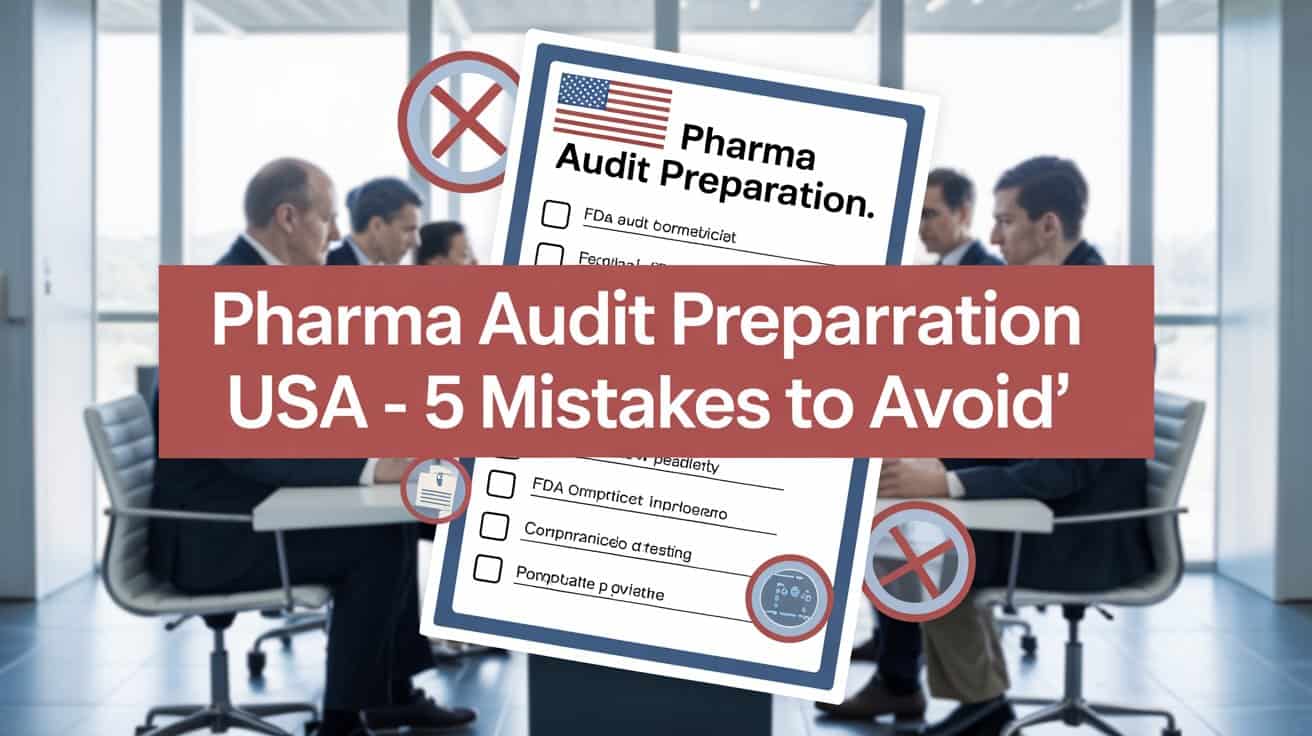Subtotal:
₹20,997.00
Top 5 Mistakes to Avoid in Pharma Regulatory Audit Preparation USA

Every pharmaceutical company operating in the United States knows that regulatory audits are not optional—they are inevitable. The U.S. Food and Drug Administration (FDA) and other regulatory authorities maintain strict oversight to ensure drug quality, safety, and compliance with Good Manufacturing Practices (GMP).
Yet despite extensive preparation, many companies make avoidable errors that can lead to warning letters, import alerts, or even plant shutdowns.
That’s why mastering pharma regulatory audit preparation USA is critical. In this blog, we’ll walk through the top 5 mistakes companies make during audit readiness and provide practical strategies to avoid them.
1. Lack of Comprehensive Documentation
When it comes to audits, the golden rule is simple:
👉 If it’s not documented, it didn’t happen.
Common Documentation Mistakes:
- Missing or incomplete Standard Operating Procedures (SOPs).
- Outdated versions of critical documents still in circulation.
- Poor record-keeping for batch manufacturing records (BMRs), quality checks, or deviations.
How to Avoid This:
- Maintain a centralized documentation system that is always audit-ready.
- Implement version control to ensure only the latest SOPs are in use.
- Train employees regularly on Good Documentation Practices (GDP).
📊 According to the FDA, nearly 60% of regulatory observations are linked to poor documentation practices.
2. Ignoring Data Integrity Requirements
With increasing reliance on digital systems, data integrity has become a top concern for the FDA.
Mistakes Companies Make:
- Using manual logs prone to errors or manipulation.
- Failing to implement audit trails in electronic systems.
- Lack of validation for computer systems (21 CFR Part 11 compliance).
Best Practices for Data Integrity:
- Adopt validated electronic systems with secure audit trails.
- Regularly perform data integrity audits.
- Provide training on ALCOA principles (Attributable, Legible, Contemporaneous, Original, Accurate).
👉 Companies that ignore data integrity during pharma regulatory audit preparation USA risk receiving the dreaded FDA Form 483.
3. Inadequate Training of Employees
Auditors often interact directly with frontline employees to assess compliance culture.
Mistakes in Training:
- Employees unaware of basic GMP practices.
- Inconsistent training records across departments.
- Failure to refresh training on regulatory updates.
How to Fix It:
- Build a robust training management system (TMS).
- Conduct mock interviews to prepare employees for real audits.
- Schedule refresher courses every 6–12 months.
💡 Tip: A confident, well-trained workforce signals strong compliance culture to auditors.
4. Poor Risk Management and CAPA Implementation
FDA auditors don’t just look at issues—they want to see how you manage risks and implement Corrective and Preventive Actions (CAPA).
Common CAPA Mistakes:
- Treating CAPA as a formality rather than a tool for improvement.
- Delays in closing CAPA actions.
- Lack of follow-up or effectiveness checks.
Risk-Based Audit Prep Strategy:
- Use ICH Q9 risk management principles to prioritize compliance risks.
- Establish a CAPA committee for cross-functional accountability.
- Track CAPA metrics to ensure timely closure.
👉 Companies with weak CAPA systems often fail regulatory audit preparation USA because it signals a culture of negligence.
5. Neglecting Mock Audits and Pre-Audit Readiness Checks
The biggest mistake? Entering an audit without testing your preparedness.
Issues with Skipping Mock Audits:
- Employees panic under real audit pressure.
- Critical gaps go unnoticed until the official inspection.
- Lack of rehearsal for presenting documents and answering auditor questions.
How to Improve:
- Conduct regular mock audits led by internal teams or external consultants.
- Simulate FDA-style inspections with surprise audits.
- Prepare a response playbook for common FDA questions.
💡 Fun Fact: Companies that conduct mock audits are 70% more likely to clear FDA inspections without major observations.
Quick Checklist: Pharma Regulatory Audit Preparation USA
✅ Centralized, updated documentation system
✅ Validated electronic systems with audit trails
✅ Regular employee training & mock interviews
✅ Strong CAPA and risk management culture
✅ Routine mock audits & pre-audit reviews
FAQs on Pharma Regulatory Audit Preparation USA
1. How often does the FDA conduct pharma audits?
It depends on risk level—typically every 2–3 years, but more frequent for high-risk facilities.
2. What is the most common mistake during regulatory audits?
Poor documentation and data integrity issues remain the top FDA observations.
3. How can pharma companies in the USA prepare better?
By investing in mock audits, training, and continuous compliance monitoring.
4. Do small pharma companies also need full audit readiness?
Yes. FDA regulations apply equally, regardless of company size.
Conclusion: Stay Audit-Ready, Always
Avoiding these 5 mistakes in pharma regulatory audit preparation USA can be the difference between smooth approval and costly regulatory actions.
Global best practices—like comprehensive documentation, data integrity systems, robust training, effective CAPA, and regular mock audits—are not just checkboxes but vital for maintaining compliance and credibility.
👉 If your organization is preparing for an FDA or MHRA audit, now is the time to strengthen your systems.
🚀 Call to Action:
Need expert guidance? Explore our Regulatory Audit Readiness Consulting Services and ensure your company passes its next inspection with confidence.





